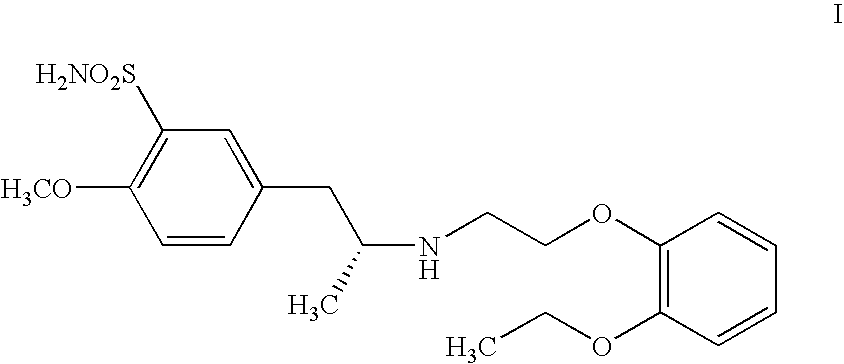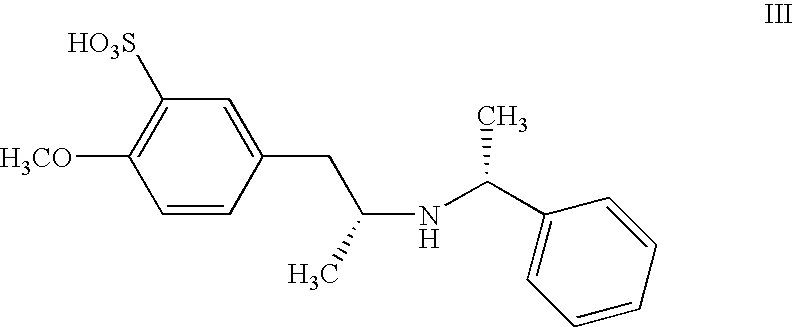Process for the preparation of tamsulosin and intermediates thereof
a technology of tamsulosin and intermediates, which is applied in the preparation of organic compounds, sulfonic acid preparations, urinary disorders, etc., can solve the problems of unsatisfactory handling and need for further resolution, and achieve the effect of reducing the problem
- Summary
- Abstract
- Description
- Claims
- Application Information
AI Technical Summary
Problems solved by technology
Method used
Image
Examples
example 1
R,R-[2-(4-methoxy-phenyl)-1-methyl-ethyl]-(1-phenyl-ethyl)-amine (formula II)
[0062]To a methanol solution of p-methoxyphenylacetone (34 g, 0.207 mol) was added R-(+)-phenyl ethylamine (26.1 ml, 0.205 mol). The solution was stirred until homogeneous and then there was added 0.75 g of a platinum oxide catalyst.
[0063]The mixture was hydrogenated at a pressure of 2 bar and at a temperature of 50° C. for 12 hours. At the end of this period, the catalyst was filtered and the filtrate evaporated until oil was obtained.
[0064]To this oil, 119 ml of ethanolic hydrogen chloride was added, and the mixture stirred for 3 hours at room temperature.
[0065]Ethanol was evaporated and to the oil obtained was added 300 ml of a mixture of acetone:MTBE (9:4) v / v.
[0066]The solid was filtered, washed with acetone, and dried, yielding 30 g of R,R-[2-(4-methoxy-phenyl)-1-methyl-ethyl]-(1-phenyl-ethyl)-amine hydrochloride after crystallization and with a purity of 96.2% in area by HPLC.
example 2
R,R-2-methoxy-5-[2-(1-phenyl-ethylamino)-propyl]-benzenesulfonic acid (formula III)
[0067]To a suspension of R,R-[2-(4-methoxy-phenyl)-1-methyl-ethyl]-(1-phenyl-ethyl)-amine hydrochloride (21 g, 0.0688 mol) in dichloromethane, cooled at 5° C., was added drop wise chlorosulfonic acid (14.7 ml, 0.22 mol).
[0068]The resulting solution was stirred at −5° C. / 5° C. for 2 hours. At the end of this period 56 ml of ethanol was added to destroy the excess of chlorosulfonic acid maintaining the temperature at −5° C. / 5° C.
[0069]Dichloromethane was removed by evaporation under vacuum.
[0070]The reaction mixture is poured into 500 ml of water. The product precipitates and is filtered and washed with water and dried, yielding 23 g of the title compound with a purity of 95% in area determined by HPLC.
example 3
R-(−)-5-(2-amino-propyl)-2-methoxy-benzenesulfonic acid (formula IV)
[0071]To a suspension of R,R-2-methoxy-5-[2-(1-phenyl-ethylamino)-propyl]-benzenesulfonic acid (20 g, 0.0572 mol) in methanol was added, carefully, 20 g of wet 5% Pd / C (0.5 g Pd), and ammonium formate (18 g, 0.285 mol).
[0072]The resulting mixture was stirred at 50° C. / 60° C.
[0073]When reaction is completed water (110 ml) was added and reaction mixture is stirred 1 hour at room temperature.
[0074]The catalyst was filtered off and the filtrate evaporated until oil was obtained.
[0075]The product is crystallized from ethanol, filtered and dried, yielding 13.2 g of the title compound with a purity of 97% in area, by HPLC.
PUM
| Property | Measurement | Unit |
|---|---|---|
| temperature | aaaaa | aaaaa |
| temperature | aaaaa | aaaaa |
| temperature | aaaaa | aaaaa |
Abstract
Description
Claims
Application Information
 Login to View More
Login to View More - R&D
- Intellectual Property
- Life Sciences
- Materials
- Tech Scout
- Unparalleled Data Quality
- Higher Quality Content
- 60% Fewer Hallucinations
Browse by: Latest US Patents, China's latest patents, Technical Efficacy Thesaurus, Application Domain, Technology Topic, Popular Technical Reports.
© 2025 PatSnap. All rights reserved.Legal|Privacy policy|Modern Slavery Act Transparency Statement|Sitemap|About US| Contact US: help@patsnap.com



